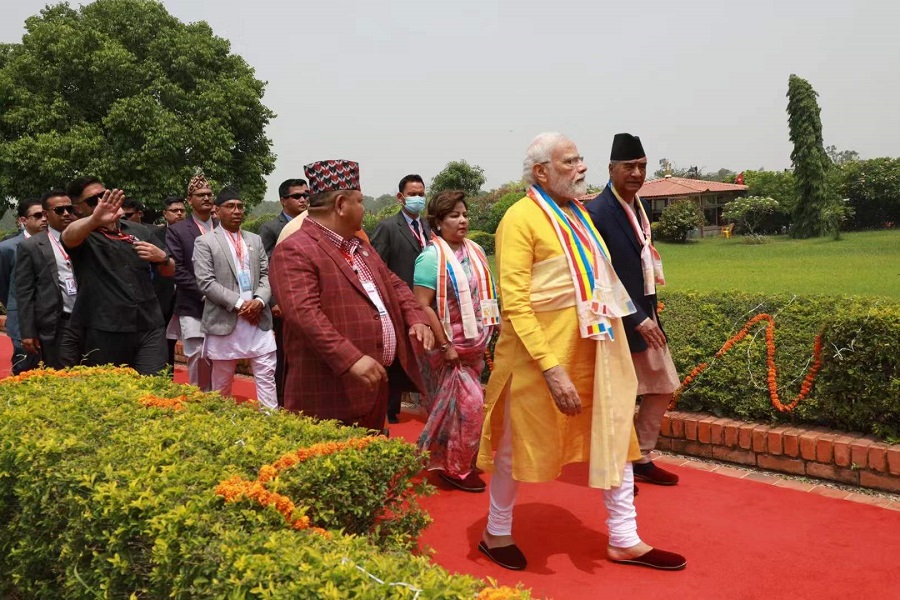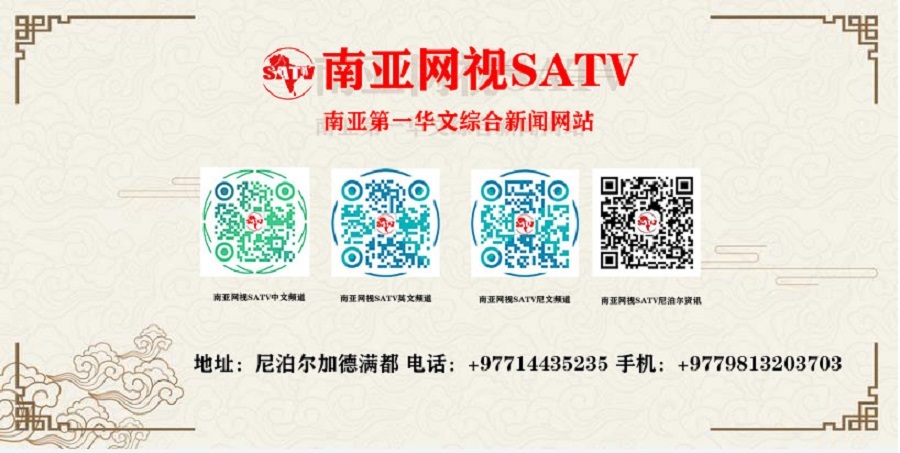
Prime Minister Sher Bahadur Deuba receives Indian Prime Minister Narendra Modi (left) in Lumbini on Monday. Modi visited Lumbini to participate in the Buddha Jayanti celebrations. Photo via Narendra Modi's Twitter
Indian Prime Minister Narendra Modi on Monday concluded an hours-long Nepal visit, laying stress on further enhancing bilateral ties, just while he also sent a political message as he continued his religious diplomacy.
Modi arrived in Lumbini on Monday morning on the occasion of the 2566th birth anniversary of Lord Buddha.
In his fifth visit to Nepal since he was first elected prime minister in 2014 and first since his reelection in 2019, Modi, however, did not fly to Kathmandu, the Capital, and instead flew back from Lumbini after attending various functions, holding bilateral talks with Prime Minister Sher Bahadur Deuba, overseeing the signing of six memorandums of understanding and addressing a gathering.
Modi pushed once again his religious diplomacy, which he started from Janakpur in 2018 by visiting Janakpur, the birthplace of Sita, to give an impetus to Nepal-India bilateral ties, powered by an agreement on energy. Nepal and India signed a memorandum of understanding to develop and implement the Arun-IV hydropower project in Sankhuwasabha.
“Buddha was born as Siddhartha in Lumbini on the day of Baishakh Purnima. On the same day, he attained enlightenment in Bodh Gaya. And on this very day, he attained mahaparinirvana in Kushinagar,” said Modi while addressing a gathering of monks, Buddhist scholars and dignitaries. “On the same date, on the same Baishakh Purnima, these stages of the life journey of Lord Buddha were not mere coincidences. It also contains the philosophical message of Buddhism, in which life, knowledge and nirvana, all three are together.”
That Buddha was born 2566 years ago in a place which now is in Nepal was never a dispute, but it has at times has served as a source of an irritant in Nepal-India ties, with a section of Nepalis harbouring the notion that India was refusing to accept the fact on Buddha’s birthplace.
This is the second time Modi has asserted Lumbini as the birthplace of the Buddha, eight years after he said so in Nepal’s then Constituent Assembly that doubled up as Parliament.
While Modi tried to make his visit look apolitical, and completely religious, he did try to take some political advantage by mentioning what he had said in Janakpur four years ago.
“I had said in Janakpur [that] without Nepal, our Ram is incomplete,” said Modi. “But I know that today when a huge temple is being built in India, people of Nepal are equally happy.”
The Indian prime minister’s reference to the temple in Ayodhya in Uttar Pradesh comes at a time when a Ram temple is being built in Ayodhyapuri of Chitwan after former prime minister KP Sharma Oli made a claim that Lord Ram was born in Nepal and not in Ayodhya.
Modi represents the Hindu nationalist Bharatiya Janata Party and his religious inclination is no secret. During his first visit to Nepal in 2014, he had offered prayers at the Pashupatinath temple and in May 2018, just ahead of national elections in India, he had visited Mustang to offer prayers at the Muktinath temple, which many say largely helped woo the Indian voters.
Now Modi is eying yet another term and preparing for 2024 elections. On Monday, he flew directly to Lucknow, the capital of Uttar Pradesh, from Lumbini to hold a meeting with Yogi Adityanath’s Cabinet.
His visit to Lumbini comes at a time when the world is seeing rapid geopolitical shifts and also after some coldness in Nepal-India ties over a host of issues, including the Kalapani region and the death of a young man from Darchula. In July, Jaya Singh Dhami had fallen into Mahakali after Indian security forces reportedly untangled a metal cable he was using to cross the river.
Ties, however, seem to be back on track, albeit gradually, especially after Prime Minister Sher Bahadur Deuba’s India visit on April 1-3.
On Monday, Modi highlighted Nepal-India ties.
“The growing and strengthening friendship between India and Nepal will work for the benefit of the entire humanity amid the kind of global situation that is emerging today,” said Modi. “We have to give our relations a height similar to the mountains of Nepal. Festivals, rituals, and even familial relations, the kind of relationship we have lived in for thousands of years, we have to link them with science, infrastructure and technology as well.”
“Buddha is beyond the geographical boundaries, he is for everyone, he belongs to everyone,” he added.
Earlier in the morning, Prime Minister Deuba welcomed Modi who had flown to Lumbini by a chopper. He overflew Nepal’s second international airport, the Gautam Buddha International Airport, just 18 kilometres from Lumbini, which was inaugurated hours before Modi’s arrival. That Modi bypassed the newly built airport has generated quite some concerns in Nepal, as his landing there could have sent a positive message.
Modi and Deuba offered prayers at the Mayadevi temple before sitting down for bilateral delegation level talks.
“India cleverly—and carefully—inserted its agenda like developing the Arun-IV hydroelectricity project, but we could not take up matters of our concerns and interest,” said Deep Kumar Upadhyay, a former Nepali ambassador to India. Upadhyay was in Lumbini to participate in the function.
“At the end of his address, I hoped and thought that our prime minister would make a request to Modi for sorting out some outstanding issues between the two countries,” he said. “But we could not enter into the main points of our concerns.”
In his address, Prime Minister Deuba said that he and Modi discussed strengthening bilateral ties in areas like culture and tourism where both sides are committed to developing a Buddhist Circuit that will link various aspects of the life of Buddha.
India and Nepal, however, are not on the same page when it comes to developing the Buddhist Circuit, though both want to develop it.
Apart from the pact on developing the hydropower project, Nepal and India signed five other understandings related to partnerships in the area of education and culture.
Once reluctant, New Delhi lately is keen to buy power from Nepal for a number of reasons—India’s increasing demand for energy, shortages and soaring prices of coal and its commitment to switching to renewable energy by 2030.
India now sees an opportunity to buy energy from Nepal by helping develop the power plants. As per the agreement on Arun-IV development, it will be jointly developed by Nepal Electricity Authority (NEA), the government of India and Sutlej Jal Vidyut Nigam (SJVN), a subsidiary of Himachal government.
Kulman Ghising, managing director of the NEA, and Nandalal Sharma, chairman of the SJVN, signed the agreement. The total installed capacity of the project, which was earlier 490.2 megawatts, now will be 695 megawatts. Nepal will receive 21.9 percent, or 152 megawatts, of electricity for free, as per the agreement.
The project site is located on the lower side of the Arun-III Hydroelectric Project, which is also currently being developed by the SJVN. Both the NEA and the SJVN will form a joint company to develop the Arun-IV project. The SJVN and the NEA will have 51 percent and 49 percent stakes, respectively. The estimated cost of the project is Rs79.12 billion.
According to the Ministry of Foreign Affairs, in the context of the official inauguration and commencement of commercial operation of the Gautam Buddha International Airport, Deuba highlighted that the airport will further facilitate connectivity, cultural linkages, and people-to-people movements and promote cultural tourism.
“He also requested additional air entry routes from Mahendranagar, Nepalgunj and Janakpur. The prime minister of India assured that authorities concerned of India would take up the matters raised by Deuba,” said the foreign ministry in its statement.
Similarly, Deuba invited interested companies from India such as the National Hydroelectric Power Corporation of India for the development of the West Seti Hydroelectric Project,” the ministry added. “The two prime ministers agreed to take up the Pancheshwar Multi-purpose Project with priority.”
Dinesh Bhattarai, who has served as foreign relations adviser to two Nepali prime ministers, said Modi’s visit to Lumbini is a welcome step but he wondered when the Nepali leadership will learn to enter into key and core bilateral issues.
“I don’t see any reason for India not giving additional air entry routes to Nepal because we have always addressed the legitimate security concerns of India,” Bhattarai told the Post. “We have a long list of pending and outstanding issues like implementation of the Mahakali Treaty signed 26 years ago. The report of the Eminent Persons’ Group on Nepal-India relations is gathering dust. We have border issues pending. But I wonder why our political leadership is failing to take up these matters seriously? Time has come for both sides to make strides in contentious and disputed issues.”













